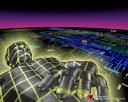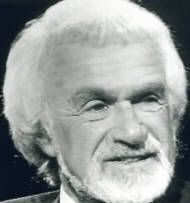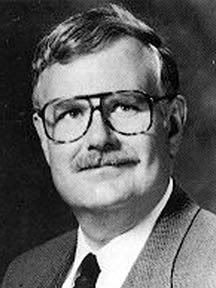ORION To The Moon In 2020
Lockheed Martin wins NASA moon contract
By SETH BORENSTEIN, AP Science Writer August 31, 2006
 NASA on Thursday gave a multibillion dollar contract to build a manned lunar spaceship to Lockheed Martin Corp., the aerospace leader that usually builds unmanned rockets. NASA on Thursday gave a multibillion dollar contract to build a manned lunar spaceship to Lockheed Martin Corp., the aerospace leader that usually builds unmanned rockets.The nation's space agency plans to use the Orion crew exploration vehicle to replace the space shuttle fleet, take astronauts to the moon and perhaps to Mars. Reusable and like Apollo and earlier spacecraft, it is perched atop the rocket. NASA estimated the cost at $7.5 billion through 2019. The last time NASA awarded a manned spaceship contract to Lockheed Martin of Bethesda, Md., was in 1996 for a spaceplane that was supposed to replace the space shuttle. NASA spent $912 million and the ship, called X-33, never got built because of technical problems. The only other competitor for the contract was a team made up of Northrop Grumman Corp., the world's largest shipbuilder and third-largest military contractor, and Boeing Co. "We feel we have an achievable design," said Doug Cooke, a deputy associate administrator when asked why Lockheed Martin was chosen over the competing team. "This is a design that is based on known capabilities. We know that this can be built so there are some differences there, perhaps." Although all of NASA's 10 centers will provide engineering support on Orion, the majority of the work will be at the Johnson Space Center in Houston and final assembly will be completed at the Kennedy Space Center in Florida. In picking Lockheed Martin for Orion, described by NASA's chief as "Apollo on steroids," NASA bypassed Apollo throwbacks Northrop Grumman of Los Angeles and its chief subcontractor Boeing of Chicago. Northrop Grumman predecessor built the Apollo lunar lander. Companies bought by Boeing built the Apollo, Gemini, and Mercury capsules, Skylab and the space shuttle. "NASA decided to do something different and go with a company that has not been in manned space before, sort of spreading the wealth and making sure they've got two contractors that know the manned space business," said aerospace industry analyst Paul Nisbet, president of JSA Research. Lockheed Martin built several unmanned probes, including: 1998's Lunar Prospector; 1976 Viking probes of Mars; Mars Reconnaissance Orbiter, which entered the red planet's orbit earlier this year; and the 1999 Mars Climate Orbiter, which crashed because of a Lockheed Martin/NASA mismatching of metric and English measurement units. Before the announcement Lockheed Martin released few details about its proposal. Their plan was heavily open-ended, allowing NASA the ultimate decision on reusability of Orion and landing sites. Lockheed Martin's initial proposal was vastly different from what NASA wanted. Its first submission looked more like the since-abandoned X-33 spaceplane and less like a capsule. NASA told Lockheed Martin it wanted an Apollo-like capsule, so the company changed its proposal. If all goes well, the first test flight of Orion will be September 2014 and astronauts could return to the moon by late 2019 or 2020, NASA estimates. Lockheed Martin vice president John Karas said, if asked, his company could make the first flight in 2013. Orion will be the Apollo capsule-like replacement for the 25-year-old space shuttle fleet that is supposed to retire in four years, after completion of the international space station. "Space is no longer going to be a destination that we visit briefly," NASA associate administrator Scott Horowitz said Thursday. "We're going to learn to live off the land like the pioneers did." This is hardly the first time NASA has made a big deal over a next-generation spaceship. Since the 1980s, NASA has spent about $4.8 billion on shuttle follow-up ships that never were built, according to the U.S. Government Accountability Office, the independent auditing arm of Congress. This time it's different, NASA claims. That's because after the Columbia accident in 2003, President Bush proposed a massive exploration plan. It would put astronauts on the moon for the first time since 1972, with plans for a home base. The plan also would ultimately send people to Mars. Orion is just part of an exploration program called Constellation that includes the Ares I and V rockets that will power the Orion capsule and a cargo vehicle into orbit and beyond. The program will reduce the risk of a fatal accident to astronauts from 1-in-200 currently for the shuttle to 1-in-2000 for the new Constellation program, Orion project manager Skip Hatfield said last week. In July, the GAO warned that NASA was heading down the wrong path in choosing an Orion-builder by late August or early September. The auditors said the space agency would be choosing a contractor before it had "well-defined requirements, a preliminary design, mature technology and firm cost estimates for the project." "This approach increases the risk that the project will encounter significant cost overruns, schedule delays and decreased capability," the GAO warned. The competition involved the three largest aerospace companies in the United States. Northrop Grumman's proposal to NASA appeared to be far more detailed in technical choices than the Lockheed Martin version, which left key decisions such as reusability and landing sites up to NASA. But others see no difference between the two. "It's between tweedledum and tweedledee," said American University public policy professor Howard McCurdy, author of several books about the American space program. "They're both using the same management systems and the same technical systems that got us to the moon the first time." "None of these companies know how to cost innovate," McCurdy said. "They're basically aerospace divisions that depend on government contracts. Their whole incentive, based on the international space station, is to drive up costs." The Orion spaceship will look familiar to the baby boomer set. It is deliberately designed to be, in the words of NASA Administrator Michael Griffin, "Apollo on steroids." NASA told the contractors to build a capsule that looks just like Apollo and can carry four astronauts to the moon and six to the international space station orbiting Earth. It should have a service module that brings it to the moon. |
SOURCE

















<< Home